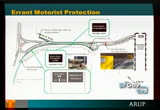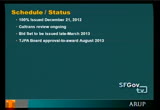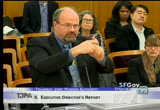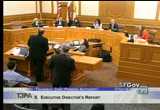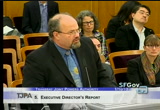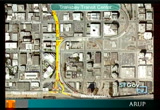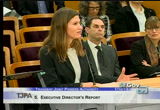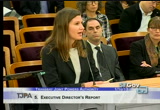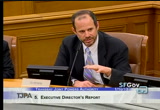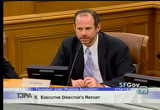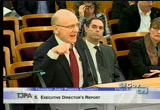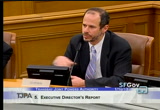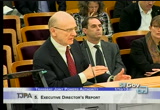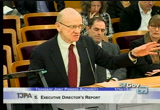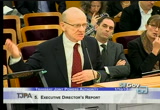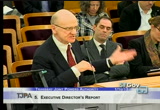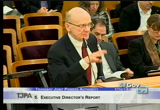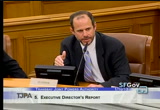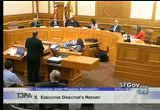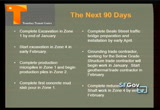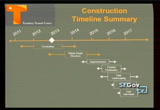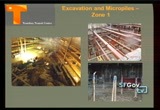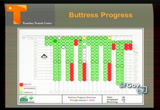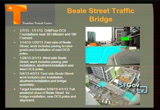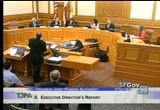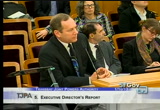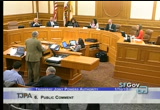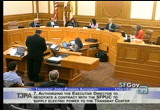tv [untitled] January 13, 2013 10:30pm-11:00pm PST
10:30 pm
right ramp to get off to the turn ramp, they will activate the barrier, which is like a big safety net. it's an antiram barrier and it will stop a truck, but it won't kill people. it swings backwards and forwards. it's a better design than the solid, big, spike ramp, if you can see it, at the federal reserve bank here. so the schedule status, i have got 100% plans and webcor and all are going through it. and caltrans is also reviewing all the plans and the bid set is is due to be issued late march of this year. and we hope to bring it to the board for approval in august. if there are any questions?
10:31 pm
>> director metcalf? >> are the buses entering the station and the buses leaving, crossing each other, so they have to stop and wait for each other? >> there are set of lights controlled. >> because this counterclockwise intrinsic is so valuable? >> we have done a lot of studies and the timing is such that you can switch across there. >> bob, i think has more to add. >> actually, the clockwise movement and in combination with the left-hand running moves that cross traffic from the entrance of the station out to a point on the ramp, where we have a signalized crossover. because it was the buses need to be clockwise run sog
10:32 pm
running so that it can drop off passengers and pick up passengers. if we didn't, it was because of that that we introduced the left-running ramp that avoids that crossover at that point where it causes a problem. >> okay. >> director reiskin. >> so i have one similar question. do we know kind of at peak future capacity how many vehicles per hour would be going through that interchange? and would this be a triggered signal that is triggered as a bus approaches? >> yes. we're modeling on 2030
10:33 pm
projections for ac transit of 120 bus and hour. so two buses a minute during the peak periods. and it is prioritized, so that in the morning, when the majority of the passengers are inbound, that it's inbound prioritized and that empty buses leaving the station would be held and would cue at the light. and the inbound buses would be prioritized. and the opposite in the evening, where the outbound buses, where the passengers are prioritized. and that keeps it all moving. >> and we have modeled that traffic for a sense of what sort of cuing is going to be happening? >> we have done that with a model and it was particularly important to caltrans that there not be a backup of inbound buss that would impact the bay bridge or the fremont street off-ramp. so we have done that modeling and we could
10:34 pm
include that in a future presentation and animation of that modeling so you could see it. >> okay. could you go back to the first slide? i wanted to just understand what current -- do all of the current ramps stay? maybe it's the next slide. i'm sorry. >> no. as part of the demolition, all of these ramps have been removed. >> so all the ramps showing aside from the yellow are gone? [ inaudible ] this is the existing fremont street off-ramp that touches down at fremont street. this is the fremont street exit ramp, that ramp will stay and, in fact will be reconfigured. i will just show you really quickly. this portion of the fremont street off-ramp will be straightened and brought up to
10:35 pm
fremont -- perpendicular to fremont. that is part of the development of block 8. this portion, this spur will be reconfigured to come straight to fremont street. this ramp here, which is part of the old bus ramp structures, and these ramps here have all been demolished, as well as these ramps coming in here. >> thank you. >> any other questions from board members? seeing none, thank you. >> i had a question on that earlier presentation. >> we can go back. >> i guess just one suggestion, if you hadn't contemplated it with the archaeological exhibit when it finishes at caltrans, city hall might be a good place to put it. >> we're looking on it for the centennial. >> very good. we probably covered this in
10:36 pm
october when we had the informational presentation on the dbe goal setting, but i just noticed when i saw that one slide, pretty volatile in terms of goals and it went up to 25 and now i know it's established from watching the video last night at 8.3. the actuals have been up in the 20s. can you just explain why that volatility and remind us why we went from the 20s down to 8. >> ? >> because we were initially receiving funds through matt, we had a lot of dbe participation on your contracts. we weren't supposed to take that into consideration when we first established our program, because we didn't have a previous dbe program. we couldn't take previous history into consideration. so we did have a very low goal just based on availability numbers in the database. i think it was 4% that first
10:37 pm
year and of course your participation was much higher. the goal did come down in the years where we were anticipating and did award the design contract, because that was such a large contract. and such a large percentage of the anticipated contracting activity. and wasn't anticipated and, in fact didn't have dbe participation advisory on that contract. so we saw the goal come down a little bit. now that we're into largely construction contracts the goal is a little bit higher and what we are seeing is that counting sbe participation, sbe participation does in my observation makes the dbe participation come down a little bit, but the sbe participation is much easier to get certified by the state or the city. and i know that fta is really pushing this element. but i do believe it's making dbe participation come down, because the dbe certification is so much more cumbersome.
10:38 pm
that is just an anecdotal observation on my part. >> thank you. that seems like an odd requirement from the federal government that you can't take the very relevant past practice and apply it to the develop of your program, but so be it. just two questions on the earlier part of the presentation. one, i appreciate on the cost slide you included a note saying that in addition, to the 20 of reserve there is $75 million of contingency. i guess a couple of questions. in total, there is less than $100 million of contingency plus reserve for still $1.6 billion program. i'm wondering if like the reserve draw-down curve you have, is there a contingency draw-down curve we're working from? and what is the basis for us knowing if we have enough contingency and reserve >> well, as you know, fta and fra have certain requirements
10:39 pm
for how much contingency and/or reserve you have to have and at some point in spring or before the summer of this year, i will be come back to the board on where we are with that; because as you know the economy is improving. so we need to be prudent and look ahead. and i'll be looking at potentially increase of the contingencies and reserves. >> okay. because i noticed also in the report that we received last night, the monthly program report. that our expenditures to-date are less than anticipated, but we have drawn-down the reserves greater and we're under that draw -down curve. do we know what is behind that combination of factors? >> is that something that you can respond to? >> i don't have that report in front of me, but jim helps prepare it. so he will be able
10:40 pm
to speak to it in more detail. >> directors i'm with the program management team and take care of the budget and scheduling stuff. the first curve you are talking about is the total expenditure curve and when we established that budget back in 2010, we had more aggressive schedule for let something of those packages than we have today. we're still holding the same end-date. so the expenditure has laged that original curve line. that is the explanation for that. for the program reserve account only, we have had a couple of major changes that we had to recognize. that kind of went off events, if you will, that i don't think will repeat. you also noticed that that curve is very erratic, if you will -- "volatile" isn't the right word, but it's nowhere near a smooth line because it's event-driven. we had originally a buttress of
10:41 pm
135 shafts. we had to increase it to over 200. that was a $25 million hit. it was a big deal. so that kind of event causes these jumps in that curve. so it's not kind of a phenomena that is really a function of time as much. so that is the best explanation i can give you for that. maria is right that we have to look at that whether there are sufficient reserves remaining to carry us to the end? >> and the reason why since 2010, that i think you just said that the packages have been coming out at a less aggressive schedule than we anticipated. what is the reason for that? and how do we catch up to meet the same end-date? >> i didn't mean to leave you with the impression that the end-date was in jeopardy
10:42 pm
because of the expenditures. >> you were saying that we're keeping the same end-date, but with the packages coming out more slowly than anticipated, how do you end up with the same end-date? >> to answer your question directly because the design has taken longer than originally anticipated. in addition to, that the original design curve, when it was set up predicated on the old construction scheme of the top-down construction. i can't remember director reiskin if you were on the board when we switched from the top-down to the bottom-up scheme. but that created a situation where we had a lot more construction work to do in the below-grade and actually allowed in a sense and i probably shouldn't use the word "design," but that it could take longer without
10:43 pm
affecting the new established end-day. does that make sense to you? >> okay. >> that curve has never actually changed from the original base expenditure. >> thank you. >> we do have questions from director metcalf. >> so whether you add all of those buttresses, going up to more than 200 and a $25 million overexpense compared to what you budgeted. is that out of the $75 million contingency? >> let me talk about that. by the way, if we need to, i don't have it on a slide, but we can have a more detailed report to provide to the board in terms of things that have occurred that cause changes in costs. and to tap into the program accounts. >> that would be great. >> so question do that for a future meeting, certainly. the $75 million, let me expound
10:44 pm
on contingencies for a minute, if i could take the board's time. there are four buckets of different types of contingency items. the most prominently displayed is the reserve account that director reiskin said is around $25 million today. that is down from 45 when we established the budget. that is intended for things that change the scope of the project. buttress increase was certainly that kind of event that would tap into that. the second type that today is around $32 or $33 million is construction contingency. the intent of that is a bucket to take care of construction change orders. the bse contractor has run into certain conditions as part of the excavating process that were not easily anticipated when he bid the job. so he had a number of change orders occur and we have that bucket to address things that occur in
10:45 pm
the construction process, like that. field-condition issues that will result in change orders. there is another bucket that is lincoln financial almost the same magnitude. it's $32 million. the csgm that has the kinds of situations, there are four of them actually. $16 million will be cost to the project one way or another. it's either going to be in webcor's pocket as an incentive or spent for a situation that would meet one of the four conditions in the contract. the last bucket, which today is pretty small is design contingency.
10:46 pm
i am covering these using reverse order in a sense. as we are designing and building the project, kind of fast-track basis, where you have started construction before the design is totally complete. when you do an estimate, the estimators have to recognize that they don't have the scope fully defined in drawings in front of them to fully develop the estimate. so they will put a contingency on top of what they see on the drawings as part of developing an estimated cost. as you complete the design, you take that contingency down to eventually zero. because you don't need to have that contingency account as the design is fully complete. today it's only about $8 million left because the design is in a relatively high state of completion. so those are the buckets that make up that $75 million that is on the footnote of that slight and the program reserve which is highlighted as a separate line.
10:47 pm
>> okay. maybe this needs to be a future discussion, but are you saying you are feeling confident that enough contingency is there more or less? >> i think what i said earlier that we're going to be coming back and probably looking for month, because it's the prudent thick to do with the economy improving. i think every project in the country is going to be looking at this. because things are getting better. there is a lot more work out there and the price of materials are starting to go up. so it's prudent for all projects to look at higher contingency reserves. >> okay. i have one more question. in your report, you referenced that you had completed or just about to complete the risk assessment and then the november project state report we got last night there was some reference to cost and design issues associated with
10:48 pm
that. is that something -- what are the issues there? >> i will come back to you on the rva. those items are a closed session item because the confidentiality and sensitivity of it. >> thank you. >> are there any other questions? seeing none, thank you. now directors we will conclude with turner construction giving you our later construction update. >> good morning directors, steve with turner construction. even with the holidays it was a very -- [ inaudible ] you have heard some of these statistics already earlier this morning, but the last period, the month of december there were no recordable or lost time incidents on the project. we have -- you saw the
10:49 pm
700,000 plus man hours to-date throughout the entire project and taking into account the current work on the transit center, all the work under webcor's contract, 600,000 craft hours through the end of 2012. and that is about 38,000 completed over the last period. the most significant progress has been made in the excavation and there is some statisticks there of where we are. the ultimate news is that we're about 50% complete with the overall excavation of the project. you heard 27 5,000 cubic yards have been removed. so we're right on track. there some of the other highlights, the water, the auxiliary water system work continues on mission street, working on 2nd back towards the beale street end of the project and that will be ongoing through most of
10:50 pm
the first-half of 2013. of some significance, with just some discussion about the buttress shaft change order, the engineers finally concluded their testing and have been able to optimize the total number of buttress shafts reducing the total number by 25. so the total drilled quantity of shaft when we evaluate at the end of the work will be less than originally anticipated. there will be some dollars coming back based on that. so we have completed to-date 172. there are ten more to go. we anticipate a mid-february, third week of february completion date at the current rate which will also expedite that work that was originally planned to finish april 1st. the micro piles are underway, and interesting, each one is tested for pull-out strength and we completed testing on 36
10:51 pm
of them so far and that is continuing as we speak. coming up in next couple of months, obviously the excavation in zone 1 should about completed by the end of january. the grounding and geothermal trade packages will start under the below-grade packages con [trao-rbgts/]. contractor. we should be able to complete the beale street bridge by april. i have information on that coming up. and hopefully complete the buttress work in the next 90 days. here is the overall timeline you have seen before. still on track with the below-grade contractor working with his geothermal and grounding contractors and submittal on the rest of the his work. the superstructure package as you heard before is out for bid and that work will get released throe the board process 2nd quarter, coming in february/march. so that will be on the april board current plan. on the exterior finishes and so
10:52 pm
on. as far as the buttress work, it continues to work along as we discussed. the work is 50% complete and still on track for a 1st quarter/early 2nd quarter 2014 completion of all the excavation. just an overview of where we are. and the slide that shows you how far the excavation has progressed with that west end close to complete excavation, moving towards the east. and the overview picture, you can see considerably more work has been done in zone 3. the first level of bracing is complete and they are starting to work on the second level. just some highlights working down between the micro pile contractor and among the bracing at the far west end, the lower right-hand photograph shows you what is left after the micro piles are complete. those are the tensioning rods that run through the middle of the micro pile and will tie into the slab that will be
10:53 pm
poured in the below-grade structure and affect that whole down progress or the whole down design on the mat slab. zone 2 continuing bracing and excavation. they have gotten to 1st street in the left-hand picture. zone 3 they are excavating under the fremont bridge. the archaeologists are always on standby and those are areas that hadn't been disturbed in the top surface and they continue to find little things in that. and the overall picture of the east end where the buttress work is going on. the red circles now represent the buttresses shafts that have been eliminated. and the green obviously the completed,elo yellow in progress and we'll be up over 174 by tomorrow. you can see the production curve as we are just about right on where we should be.
10:54 pm
the quality control work continues on the buttress shafts with the coring and testing the interface between the shafts and just some pictures of them completing a few more shafts. the awss work continues. that is all on mission street now. so what is coming up january, february and the very first weekend in april? will be the preparation and support structures for the beale street bridge. we plan to do that on a friday night road closure with an early monday re-opening. we have been able to do that on the other two bridges. this just gives you an idea of the prep work that has to occur and the time periods and of course the support piles will require road closures on beale street. and mr.
10:55 pm
and is there is muni that necessitates where muni has to be taken down and reinstalled. budgeting information, there has been plenty of discussion on that. we run 63% on local labor and continue to hit the similar numbers throughout the general areas. san francisco still contribution about 20% of the labor to the project. and these "around the house" are the trades that are currently working and the numbers. any questions? >> director reiskin? >> great news, that is more than 10% reduction and you suggested a little mvp might be coming bab, is that a significant analyst? >> the way the contract is
10:56 pm
written, that it was a price for the installation of the 125 and the change order to add the 72 for a total count of 207. each shaft, each foot of the drilled shaft is what we calculated on. the original design length was 241' and that was what the bid was based on with a total estimated drill amount. so what we need to do now is wait until they are 100% done, the last shaft is drilled and from a quality perspective, approved, accepted. and then we'll say we add up the total feet drilled of each one and do the multiplication. because there are three different types of shaft with three different prices per foot. yes, the average cost of a shaft is well over $200,000 at
10:57 pm
the 241' estimate. and more importantly it saves us time. as you recall the buttress work was controlling a lot of the project and this helps us tremendously there as well. any other questions? >> seeing none, thank you very much. >> thank you. >> that concludes my report. >> thank you. we'll move on to item no. 6, which is public comment? >> i have not received any indication that a member of the public wants to address you under this item. >> if you want to address the board, please come up to the mic and you will have two minutes. >> hi, thank you i'm jim patrick with patrick and company in san francisco and i have watched this board go on and analyze this agreement with heines behind closed doors for the last year and a half and
10:58 pm
finally reading the minutes which are about to be approved this deal has concluded apparently. i would like to know from the board, why is this a good deal for us? no. 1. and no. 2 could i get a copy of this deal to evaluate it? thank you. >> thank you. is there any other public comment? seeing none, we will close public comment. and we'll move on to our regular calendar, which brings us to item no. 7. >> item no. 17 authorizing the executive director to negotiate a contract with the san francisco public utilities commission. >> and directors bob beck will report on this item. >> thank you, we did get a really detailed summary, which i appreciate. since we did a detailed one, we could just answer questions.
10:59 pm
>> the detail was at a pretty high level and really at the end of the day boils down to what are the economic terms of two proposals. so we did receive proposals from both pg&e and puc to provide power source to the tjpa and based on the schedule for finalizing construction documents this may we really need to commit to the space program that would be associated with one service or the other. that is why we're bringing this issue to you today. under the cpuc as a regulated utility it's pretty straightforward that tjpa would fall underneath the cpuc rate e20 classification and in the proposal that the puc has submitted to us, they would provide us a rate that would be 10% lower than the published cpuc rate that pg&e would be required
90 Views
IN COLLECTIONS
SFGTV: San Francisco Government Television Television Archive
Television Archive  Television Archive News Search Service
Television Archive News Search Service 
Uploaded by TV Archive on

 Live Music Archive
Live Music Archive Librivox Free Audio
Librivox Free Audio Metropolitan Museum
Metropolitan Museum Cleveland Museum of Art
Cleveland Museum of Art Internet Arcade
Internet Arcade Console Living Room
Console Living Room Books to Borrow
Books to Borrow Open Library
Open Library TV News
TV News Understanding 9/11
Understanding 9/11